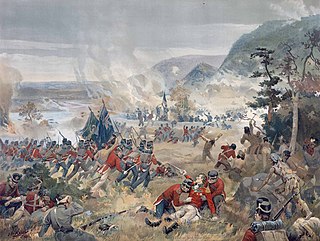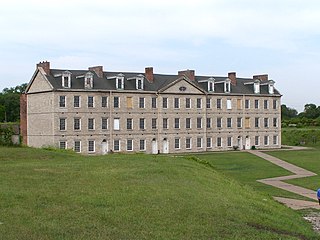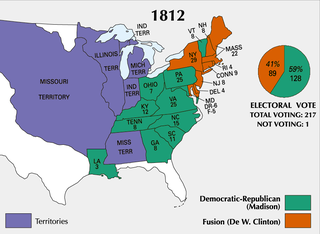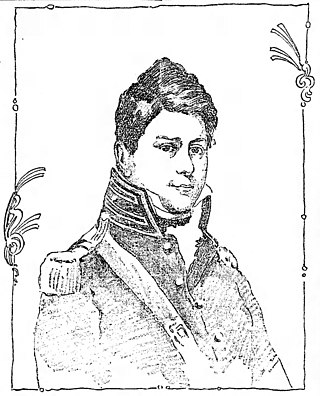
Major-General Sir Isaac Brock KB was a British Army officer and colonial administrator from Guernsey. Brock was assigned to Lower Canada in 1802. Despite facing desertions and near-mutinies, he commanded his regiment in Upper Canada successfully for many years. He was promoted to major general, and became responsible for defending Upper Canada against the United States. While many in Canada and Britain believed war could be averted, Brock began to ready the army and militia for what was to come. When the War of 1812 broke out, the populace was prepared, and quick victories at Fort Mackinac and Detroit defeated American invasion efforts.

Henry Dearborn was an American military officer and politician. In the Revolutionary War, he served under Benedict Arnold in his expedition to Quebec, of which his journal provides an important record. After being captured and exchanged, he served in George Washington's Continental Army. He was present at the British surrender at Yorktown. Dearborn served on General George Washington's staff in Virginia.

The Battle of Queenston Heights was the first major battle in the War of 1812. Resulting in a British victory, it took place on 13 October 1812 near Queenston, Upper Canada.

William Hull was an American soldier and politician. He fought in the American Revolutionary War and was appointed as Governor of Michigan Territory (1805–13), gaining large land cessions from several American Indian tribes under the Treaty of Detroit (1807). He is most widely remembered, however, as the general in the War of 1812 who surrendered Fort Detroit to the British on August 16, 1812 following the Siege of Detroit. After the battle, he was court-martialed, convicted, and sentenced to death, but he received a pardon from President James Madison and his reputation somewhat recovered.

The Battles of Frenchtown, also known as the Battle of the River Raisin and the River Raisin Massacre, were a series of conflicts in Michigan Territory that took place from January 18–23, 1813, during the War of 1812. It was fought between the United States of America and a joint force of British and Native American near the River Raisin in Frenchtown.

The siege of Detroit, also known as the surrender of Detroit or the Battle of Fort Detroit, was an early engagement in the War of 1812. A British force under Major General Isaac Brock with Native American allies under Shawnee leader Tecumseh used bluff and deception to intimidate U.S. Brigadier General William Hull into surrendering the fort and town of Detroit, Michigan, along with his dispirited army which actually outnumbered the victorious British and Indians.

The Battle of Maguaga was a small battle between British troops, Canadian militia and Tecumseh's natives against a larger force of American troops, Ohio Volunteers and Michigan Legion near the Wyandot village of Maguaga which become The Township of Monguagon Township, Michigan in what is now The City of Riverview, Michigan.
Nathan Heald was an officer in the U.S. Army, during the War of 1812. He was in command of Fort Dearborn in Chicago during the Battle of Fort Dearborn.
Major-General Henry Patrick Procter was a British Army officer who served in the Canadas during the War of 1812. He is best known for being decisively defeated in 1813 by American forces, which left the western portion of Upper Canada under U.S. control. Procter is regarded by numerous commentators as an inept leader who relied heavily on textbook procedure. His "going by the book" is attributed to his lack of any combat experience before coming to Canada.

Fort Wayne is located in the city of Detroit, Michigan, at the foot of Livernois Avenue in the Delray neighborhood. The fort is situated on the Detroit River at a point where it is under half a mile to the Ontario shore. The original 1848 limestone barracks still stands, as does the 1845 fort. On the grounds but outside the original fort are additional barracks, officers quarters, a recreation building, a theater, commissary, guard house, garage, and stables. A large warehouse and the post fire station were torn down in 1976 and the two-story hospital was torn down in 2007.

Fort Pontchartrain du Détroit or Fort Detroit (1701–1796) was a fort established on the north bank of the Detroit River by the French officer Antoine de la Mothe Cadillac and the Italian Alphonse de Tonty in 1701. In the 18th century, French colonial settlements developed on both sides of the river, based on the fur trade, missions, and farms.
General Charles Larned was an American lawyer, military officer, and politician. He fought in the War of 1812 and was Attorney General of Michigan Territory.

Daniel Dobbins was a sailing master in the United States Navy and captain in the United States Revenue Cutter Service. He fought in the War of 1812 and was in charge of the building of the ships at Erie, Pennsylvania, that Oliver Hazard Perry commanded in the Battle of Lake Erie.

The following is a partial list of events from the year 1812 in the United States. After years of increasing tensions, the United States declares war on the British Empire, starting the War of 1812.
Benjamin Franklin Graves (1771–1813) was a politician and military leader in early 19th-century Kentucky. During the War of 1812, Graves served as a major in the 2nd Battalion, 5th Kentucky Volunteer regiment. Together with other officers, he commanded Kentucky troops in the Battle of Frenchtown on January 22, 1813, in Michigan Territory. This was part of an effort by Americans to take the British-controlled fort at Detroit, Fort Shelby. This battle had the highest number of American fatalities in the war: of 1,000 American troops, nearly 400 were killed in the conflict, and 547 were taken prisoner. The next day an estimated 30-100 Americans were killed by Native Americans after having surrendered.

Abraham Edwards was an American physician and politician in the U.S. state of Michigan. He served in the U.S. Army during the War of 1812 and was president of the Michigan Territorial Council for a majority of its existence.
Frédérick Rolette, born in Quebec City on September 23, 1785, was an officer of the Royal Navy who served in the Provincial Marine during the War of 1812.
The Western Theater of the War of 1812 was an area of interest during the War of 1812 between the United States of America and the United Kingdom. Far from the Atlantic Coast and large cities, logistics and communication were more challenging in the western territories and the United States frontier. For many Native American nations involved, this war was a continuation of the defense of their lands against encroaching settlers.















